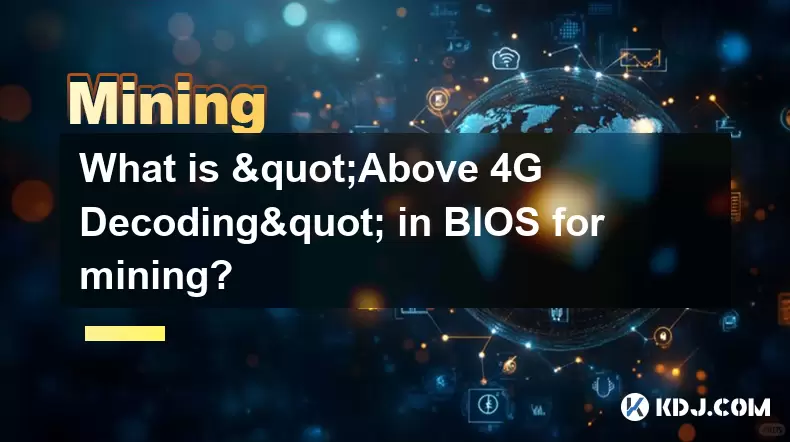-
 bitcoin
bitcoin $118548.520763 USD
3.67% -
 ethereum
ethereum $4352.564943 USD
4.79% -
 xrp
xrp $2.964058 USD
4.22% -
 tether
tether $1.000565 USD
0.05% -
 bnb
bnb $1028.372955 USD
1.46% -
 solana
solana $221.373507 USD
6.00% -
 usd-coin
usd-coin $0.999933 USD
0.02% -
 dogecoin
dogecoin $0.248633 USD
6.85% -
 tron
tron $0.341444 USD
2.38% -
 cardano
cardano $0.852946 USD
5.82% -
 hyperliquid
hyperliquid $47.869306 USD
6.15% -
 chainlink
chainlink $22.561476 USD
6.01% -
 ethena-usde
ethena-usde $1.001258 USD
0.05% -
 avalanche
avalanche $30.660000 USD
2.06% -
 stellar
stellar $0.400917 USD
9.76%
What is "Above 4G Decoding" in BIOS for mining?
Enabling "Above 4G Decoding" in BIOS allows GPUs to access memory beyond 4GB, improving stability and performance in mining rigs with multiple high-memory graphics cards.
Jul 13, 2025 at 10:08 am

Understanding BIOS and Its Role in Mining
The BIIOS (Basic Input/Output System) is a crucial component of any computer system, serving as the foundational software that initializes hardware during the boot process. For cryptocurrency mining rigs, especially those using GPUs, optimizing BIOS settings can significantly affect performance and stability.
In mining operations, where systems often run continuously with heavy GPU loads, ensuring that every hardware component communicates efficiently with the motherboard is essential. One such setting that directly impacts this communication is 'Above 4G Decoding.' This option is typically found in the BIOS settings under PCIe configuration or advanced chipset features.
Above 4G Decoding allows the system to allocate memory addresses above the traditional 4GB boundary for PCI Express devices like GPUs. This becomes particularly important when dealing with multiple high-memory GPUs used in mining setups.
What Does 'Above 4G Decoding' Mean?
The term 'Above 4G Decoding' refers to how the system handles memory addressing for peripheral devices connected via PCIe slots. In older systems, the memory addressing limit was capped at 4GB due to the 32-bit architecture. However, modern systems use 64-bit architectures that support much larger memory spaces.
When 'Above 4G Decoding' is enabled, it tells the motherboard to allow PCIe devices — such as graphics cards — to access memory addresses beyond the 4GB threshold. This is vital for systems with multiple GPUs, each potentially having 8GB or more of VRAM. Without enabling this feature, some of the memory on these cards may become inaccessible or cause conflicts.
- Memory Addressing Limitation: Older systems restricted PCIe devices to 4GB of addressable space.
- Modern Expansion: Enabling Above 4G Decoding removes this limitation, allowing full utilization of GPU memory.
Why Is It Important for Mining?
Cryptocurrency mining requires intense computational power, often provided by multiple GPUs working simultaneously. Each GPU needs direct and unobstructed access to system memory for optimal performance. If a GPU cannot access all its allocated memory due to address conflicts, it may crash or operate inefficiently.
Enabling 'Above 4G Decoding' ensures that each GPU in your mining rig can map its entire memory range without overlapping with other devices. This reduces the risk of system instability and improves hashing efficiency.
- Prevents Memory Conflicts: Ensures no overlap between memory ranges assigned to different GPUs.
- Enhances Stability: Reduces crashes and reboots caused by memory allocation errors.
How to Enable 'Above 4G Decoding' in BIOS
Accessing and modifying BIOS settings varies slightly depending on the motherboard manufacturer, but the general steps remain consistent across most platforms.
To enable 'Above 4G Decoding,' follow these instructions:
- Restart Your System: Initiate a reboot and press the appropriate key (usually Del, F2, or Esc) to enter BIOS setup.
- Navigate to Advanced Settings: Look for sections labeled 'Advanced,' 'Chipset,' or 'PCIe Configuration.'
- Locate the Option: Search for 'Above 4G Decoding,' sometimes listed as 'PCIe Above 4G Decoding' or similar.
- Enable the Feature: Use arrow keys to change the value from 'Disabled' to 'Enabled.'
- Save and Exit: Choose the option to save changes and restart the system.
Potential Issues When Not Enabled
Failing to enable 'Above 4G Decoding' in mining configurations can lead to several issues. These problems might not be immediately apparent but can manifest over time as system load increases.
Some common symptoms include:
- GPU Detection Failures: The system may fail to detect one or more GPUs properly.
- Random Crashes: Unexpected shutdowns or freezes during mining sessions.
- Reduced Hash Rates: Performance degradation due to partial GPU memory utilization.
If you experience any of these symptoms and are running multiple GPUs, checking and enabling 'Above 4G Decoding' should be among the first troubleshooting steps.
Frequently Asked Questions
Q1: Can enabling 'Above 4G Decoding' damage my hardware?No, enabling this feature does not pose any physical risk to your hardware. It simply adjusts how memory addresses are assigned to PCIe devices and is a safe and recommended setting for multi-GPU mining rigs.
Q2: Do all motherboards support 'Above 4G Decoding'?Most modern motherboards with UEFI BIOS support this feature, especially those designed for gaming or workstation use. However, some budget or older models may lack this option. Always check your motherboard’s manual or specifications online before purchasing.
Q3: Will enabling 'Above 4G Decoding' improve mining performance on single GPU setups?It is unlikely to have a noticeable impact on single GPU systems unless the GPU has a large amount of onboard memory (e.g., 16GB or more). In such cases, enabling the feature may still provide benefits.
Q4: What if I don't see the 'Above 4G Decoding' option in BIOS?If the option is missing, it could be due to motherboard limitations or an outdated BIOS version. Check for available firmware updates from the manufacturer's website and install them if applicable.
Disclaimer:info@kdj.com
The information provided is not trading advice. kdj.com does not assume any responsibility for any investments made based on the information provided in this article. Cryptocurrencies are highly volatile and it is highly recommended that you invest with caution after thorough research!
If you believe that the content used on this website infringes your copyright, please contact us immediately (info@kdj.com) and we will delete it promptly.
- BlockDAG, DOGE, HYPE Sponsorship: Crypto Trends Shaping 2025
- 2025-10-01 00:25:13
- Deutsche Börse and Circle: A StableCoin Adoption Powerhouse in Europe
- 2025-10-01 00:25:13
- BlockDAG's Presale Buzz: Is It the Crypto to Watch in October 2025?
- 2025-10-01 00:30:13
- Bitcoin, Crypto, and IQ: When Genius Meets Digital Gold?
- 2025-10-01 00:30:13
- Stablecoins, American Innovation, and Wallet Tokens: The Next Frontier
- 2025-10-01 00:35:12
- NBU, Coins, and Crypto in Ukraine: A New Yorker's Take
- 2025-10-01 00:45:14
Related knowledge

The difference between staking and mining
Sep 24,2025 at 05:18am
Understanding Staking in the Cryptocurrency Ecosystem1. Staking involves holding funds in a cryptocurrency wallet to support the operations of a block...

How to participate in testnet mining?
Sep 22,2025 at 09:18am
Understanding Testnet Mining in the Crypto Ecosystem1. Testnet mining is a method used by blockchain developers to simulate real-world conditions on a...

How to dispose of abandoned mining machines?
Sep 19,2025 at 08:19pm
Assessing the Condition of Abandoned Mining Rigs1. Begin by inspecting each mining machine for visible damage, corrosion, or missing components. Machi...

How to identify high-quality mining pools?
Sep 21,2025 at 03:19pm
Reputation and Track Record1. A mining pool’s reputation is built over time through consistent performance and transparency. Pools that have operated ...

Advantages of decentralized mining pools
Sep 20,2025 at 04:36pm
Enhanced Security and Resistance to Censorship1. Decentralized mining pools operate on blockchain-based smart contracts, eliminating the need for a ce...

What is mining machine overclocking?
Sep 21,2025 at 07:19pm
Understanding Mining Machine Overclocking1. Mining machine overclocking refers to the process of increasing the operating frequency of a cryptocurrenc...

The difference between staking and mining
Sep 24,2025 at 05:18am
Understanding Staking in the Cryptocurrency Ecosystem1. Staking involves holding funds in a cryptocurrency wallet to support the operations of a block...

How to participate in testnet mining?
Sep 22,2025 at 09:18am
Understanding Testnet Mining in the Crypto Ecosystem1. Testnet mining is a method used by blockchain developers to simulate real-world conditions on a...

How to dispose of abandoned mining machines?
Sep 19,2025 at 08:19pm
Assessing the Condition of Abandoned Mining Rigs1. Begin by inspecting each mining machine for visible damage, corrosion, or missing components. Machi...

How to identify high-quality mining pools?
Sep 21,2025 at 03:19pm
Reputation and Track Record1. A mining pool’s reputation is built over time through consistent performance and transparency. Pools that have operated ...

Advantages of decentralized mining pools
Sep 20,2025 at 04:36pm
Enhanced Security and Resistance to Censorship1. Decentralized mining pools operate on blockchain-based smart contracts, eliminating the need for a ce...

What is mining machine overclocking?
Sep 21,2025 at 07:19pm
Understanding Mining Machine Overclocking1. Mining machine overclocking refers to the process of increasing the operating frequency of a cryptocurrenc...
See all articles










































































